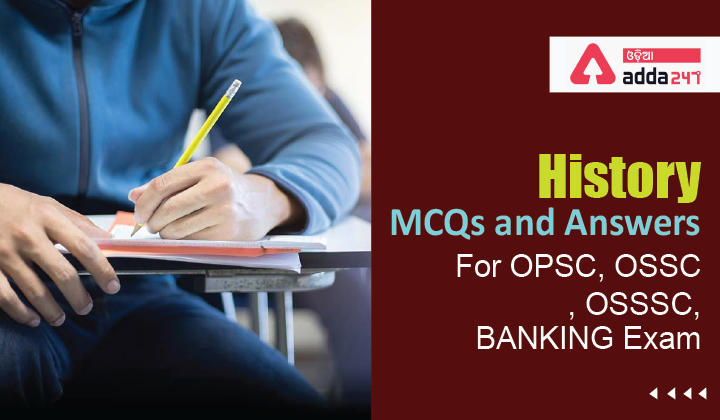History MCQs and Answers: History MCQs are very important for OPSC, OSSC, OSSSC & Other State Exams. Aspirants who are willing to apply for the various Government exams 2022 must go through the topics of History for competitive exams, as History is a key part of the syllabus.
History MCQs
Q1. The words “Satyameva Jayate” in the State Emblem of India were taken from
(a) Mundaka Upanishads
(b) Sama Veda
(c) Rig Veda
(d) Ramayana
Q2. The famous rock-cut temple of Kailasa is at
(a) Ajanta
(b) Badami
(c) Mahabalipuram
(d) Ellora
Q3. The Harappan Civilisation was discovered in the year:
(a) 1935
(b) 1942
(c) 1901
(d) 1921
Q4. The ‘Junagarh Rock Inscription’ associated to?
(a) Rudradaman
(b) Bimbisara
(c) Chandragupta II
(d) Gautamiputra Satakarni
Q5. Nalanda University was a great centre of learning, especially in
(a) Buddhism
(b) Jainism
(c) Vaishnavism
(d) Tantra
Q6. Who is hailed as the “God of Medicine” by the practitioners of Ayurveda?
(a) Susruta
(b) Chyavana
(c) Dhanwantari
(d) Charaka
Q7. In the Western India The Chalukyas dynasty succeeded by?
(a) Cholas
(b) Kakatiyas
(c) Pallavas
(d) Rashtrakutas

Q8. Which of the following domesticated animals was absent in the terracottas of the Indus civilisation?
(a) Buffalo
(b) Sheep
(c) Cow
(d) Pig
Q9. Which among the following is the sacred book of the Buddhists?
(a) Upanishad
(b) Vedas
(c) Tripitaka
(d) Jatakas
Q10. Who was the first known Gupta ruler?
(a) Sri Gupta
(b) Chandragupta I
(c) Ghatotkacha
(d) Kumaragupta I
Q11. Name the Buddha belonged to?
(a) Gnathrika.
(b) Maurya.
(c) Shakya.
(d) Kuru.
Q12. Lord Mahavira died at?
(a) Saravana Belagola.
(b) Lumbini Garden.
(c) Kalugumalai.
(d) Pavapuri.
Q13. The coins of which of the following reveal their love for music?
(a) Mauryas.
(b) Nandas.
(c) Gupta’s.
(d) Cholas.
Q14. By which Charter Act , the east india company monopoly of trade with China come to an end?
(a) Charter Act 1793.
(b) Charter Act 1813.
(c) Charter Act 1833.
(d) Charter Act 1855.
Q15. Most of the chola temples were dedicated to?
(a) Vishnu.
(b) Shiva.
(c) Brahma.
(d) Durga.
History MCQs and Answers:
S1. Ans.(a)
Sol.”Satyameva Jayate” is a mantra from the ancient Indian scripture Mundaka Upanishad.
S2. Ans.(d)
Sol.The Kailasanatha temple (Cave 16) is one of the 32 cave temples and monasteries known collectively as the Ellora Caves. Its construction is generally attributed to the 8th century Rashtrakuta king Krishna I in 756-773 CE. The temple architecture shows traces of Pallava and Chalukya styles.
S3. Ans.(d)
Sol.Alexander Cunningham published the first Harappan seal (with an erroneous identification as Brahmi letters). It was half a century later, in 1912, that more Harappan seals were discovered by J. Fleet, prompting an excavation campaign under Sir John Hubert Marshall in 1921-22 and resulting in the discovery of the civilization at Harappa by Sir John Marshall, Rai Bahadur Daya Ram Sahni and Madho Sarup Vats, and at Mohenjo-daro by Rakhal Das Banerjee, E. J. H. MacKay, and Sir John Marshall.
S4. Ans.(a)
Sol.The Junagadh rock inscription of Rudradaman, also known as the Girnar Rock inscription of Rudradaman, was inscribed by the Western Satraps ruler Rudradaman I. It is located in Girnar near Junagadh, Gujarat, India, and dated to circa 130–150 CE.
S5. Ans.(a)
Sol.Nalanda was a Mahavihara, a large Buddhist monastery, in the ancient kingdom of Magadha (modern-day Bihar) in India. The site is located about 95 kilometres southeast of Patna near the town of Bihar Sharif, and was a centre of learning from the fifth century CE to c. 1200 CE. It is a UNESCO World Heritage Site.
S6. Ans.(c)
Sol.Dhanvantari appears in the Puranas as the god of Ayurveda. It is common practice in Hinduism for worshipers to pray to Dhanvantari seeking his blessings for sound health for themselves and/or others, especially on Dhanteras or Dhanwantari Trayodashi. Govt. Of India has declared that Dhanwantari Trayodashi every year would be celebrated as “National Ayurveda Day”.
S7. Ans.(d)
Sol.In the western Deccan, the rise of the Rashtrakutas in the middle of the 8th century eclipsed the Chalukyas of Badami before being revived by their descendants, the Western Chalukyas, in the late 10th century.
S8. Ans.(c)
Sol.The arts of Indus Valley civilisation, one of the earliest civilisations of the world, emerged during the second half of the third millennium (Bronze Age). The forms of art found from various sites of civilisation include sculptures, seals, pottery, gold ornaments, terracotta figures, etc.
S9. Ans.(c)
Sol.Tripiṭaka, also referred to as Tipiṭaka, is the traditional term for the Buddhist scriptures. The version canonical to Theravada Buddhism is often referred to as Pali Canon in English.
S10. Ans.(a)
Sol.Śri Gupta was a pre-imperial Gupta king in northern India and the founder of the Gupta dynasty.
S11. (C)
Sol.
Buddha was born in Lumbini , Nepal who was the leader of Shakya clan.
S12. (d)
Sol.
Lord Mahavira died at pavapuri at 527 B.C.
S13. (C)
Sol.
The Gupta’s minted gold coins in abundance also known as dinars.
The coins were depicted with the images of ruler’s in various pose.
Some coins depicted samudragupta playing Veena.
S14. (b)
Sol.
By the Charter Act of 1813 the trade monopoly of East india company comes to an end.But the monopoly on the tea trade with China was unchanged.
S15. (b)
Sol.
Most of the chola temples were dedicated to Shiva.














